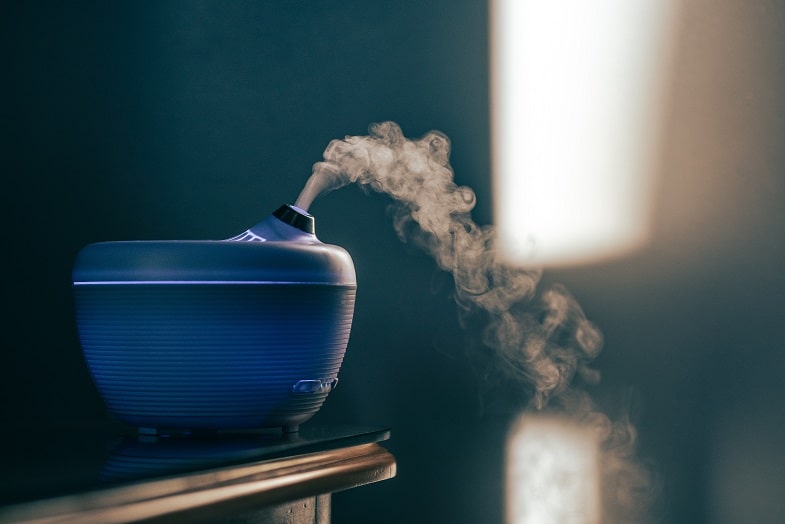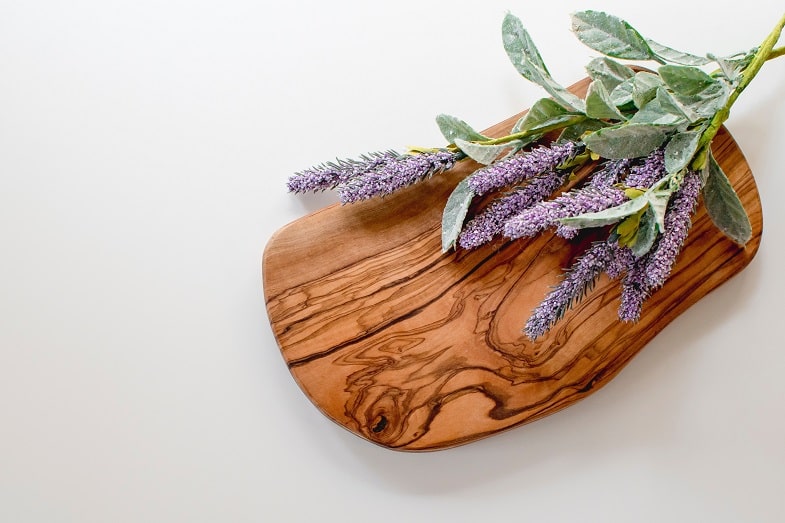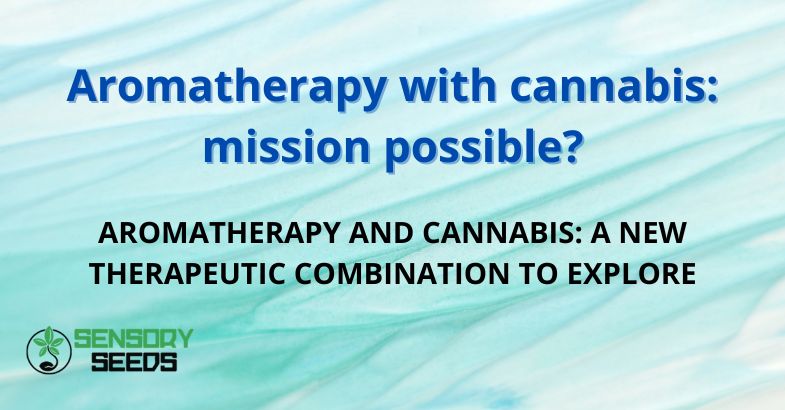Published on: 16/10/2023
AROMATHERAPY AND CANNABIS: A NEW THERAPEUTIC COMBINATION TO EXPLORE
Did you know that cannabis, in addition to being widely debated for its therapeutic properties, could also play a key role in aromatherapy?
This ancient practice, but at the same time always current, is rapidly evolving with the entry into the field of new natural substances in which a growing part of public opinion has more and more interest. And cannabis is absolutely one of the leaders in this process.
In the following article we will explore aromatherapy further, describing the history of this fascinating practice and explaining how essential oils can offer a unique approach to self-care. We will then analyze the possible use of cannabis in this context, examining the pros and cons of a similar choice.
Aromatherapy in a nutshell
Aromatherapy is a practice that exploits the very essence of nature, essential oils, to promote profound physical and mental well-being. These substances, extracted from plants, are volatile and perfumed concentrates that are real allies of our health, having therapeutic properties that act on various levels.
In particular, they interact with our body by stimulating both the olfactory and skin systems. Through the sense of smell, essential oils can influence mood and emotions, while if applied to the skin they stimulate the nervous system, strengthen the immune system and promote correct metabolism.
The millennial roots of aromatherapy: a journey through human history
The roots of aromatherapy go deep into the fabric of human history, tracing a journey through millennia and disparate cultures.
It is believed that the first civilizations to recognize and use the beneficial properties of aromatic plants were those of ancient Egypt, Mesopotamia and India. The Egyptians, for example, exploited the power of essential oils not only in the complex practice of mummification, but also in the medical field, in beauty care and in religious rites. Similarly, the Mesopotamians used the essences of aromatic plants to spread perfumes in rooms and to create ointments and balms, while in India essential oils were crucial elements in Ayurvedic medicine and meditation practice.
On the wings of commercial and cultural exchanges with the East, aromatherapy made its entrance into the Greco-Roman world. The Greeks learned from the Egyptians the sophisticated art of distilling essential oils, then using them for the treatment of wounds, to enhance beauty and promote psychophysical well-being. From them, the Romans inherited the knowledge of aromatic plants, using them widely in spas, to perfume clothes and bodies, as well as in festive celebrations.
However, during the Middle Ages, aromatherapy underwent a period of decline, mainly due to the closure of trade with the East and the general distrust of pagan practices. Despite this, some traditions resisted, above all thanks to the work of the monks who continued to cultivate aromatic plants in their monastic gardens, using them both in medicine and in liturgical rites. In parallel, prominent Arab doctors such as Avicenna and Averroes kept the practice alive, continuing to study and use essential oils.


During the Renaissance, aromatherapy experienced a renaissance thanks to the rediscovery of classical texts and the resumption of contacts with the Orient. Illustrious doctors and alchemists, such as Paracelsus and Marsilio Ficino, became interested in essential oils, exploring and experimenting with their beneficial effects on the body and mind. Furthermore, they were widely employed as possible remedies against the devastating plague epidemics that afflicted Europe.
However, in the modern era, aromatherapy has undergone a crisis following the evolution of chemistry and pharmacology, which have favored the use of synthetic remedies to the detriment of natural ones. Nonetheless, pioneers such as the French doctor René-Maurice Gattefossé and the English biochemist Jean Valnet rediscovered the therapeutic properties of essential oils, bringing them back to the attention of the medical and scientific world. They incorporated them into the practice of natural medicine, starting an aromatherapy renaissance movement.
Today, aromatherapy is considered a discipline in its own right, recognized and valued by a broad spectrum of health and wellness professionals. Essential oils, thanks to their availability on the market, are within the reach of anyone who wishes to experience their benefits and improve their quality of life.
However, aromatherapy is not just a means of achieving physical and psychological well-being. It is also a deep bond with our cultural and historical roots, a direct line that connects us to the ancient civilizations that were the first to discover and exploit the healing power of plants. It is, in fact, an ancient but still tremendously relevant practice in our modern world, a means of reconnecting with the inherent healing wisdom of nature.
Read also: An overview of the close relationship between cannabis and music
The main methods of use of essential oils for aromatherapy
Essential oils can be used in an infinite number of ways: diffused in the air to perfume the environment and create specific atmospheres, used in regenerating body massages, inhaled to promote respiratory well-being or, with the advice of an expert, ingested with caution.
Aromatherapy is considered a form of alternative or complementary medicine. It does not replace traditional medical therapies, but effectively complements them, offering relief from various ailments or enhancing general well-being. Through this practice, a beneficial action is exerted above all on the sense of smell, which in turn stimulates the nervous system, influencing emotions, mood, concentration and creativity.
For optimal use of aromatherapy, the choice of essential oils should be tailored to specific individual needs and preferences. Each oil has unique characteristics and specific indications for use: lavender for example, with its aromatic notes, induces a feeling of calm and relaxation, lemon tones and purifies, while mint refreshes and decongests.
Essential oils can be used individually or blended together to create powerful aromatic synergies. However, to take full advantage of their properties and combine the different essences correctly, it is necessary to have a thorough knowledge of each of them. In general, it is recommended not to mix more than three or four oils at a time and to respect the proportions between the different essences.
To spread the oils in the environment, you can use special diffusers or burners, or scented candles. This method not only creates a pleasant atmosphere, but also allows you to benefit from the properties of the active ingredients of plants, promoting relaxation, concentration, air purification or the prevention of seasonal diseases.
The application of essential oils on the skin takes place through massages or compresses, but it is essential that they are always diluted in a basic vegetable oil, such as almond or jojoba oil. In fact, pure oils could be irritating or allergenic. A massage with essential oils can relax muscles, stimulate circulation, relieve pain or heal the skin.
Finally, the inhalation of essential oils can take place directly from the bottle, from a handkerchief, through suffumiges or nasal sprays. This method is particularly suitable for clearing the airways, to combat cold symptoms or headaches, or to calm stress and promote a sense of tranquility.
The most sought-after essential oils and their distinctive properties
In the enchanting world of aromatherapy, there are essential oils that are particularly sought after for their distinctive benefits. Let’s see who are the protagonists of this aromatic panorama and what characteristics make them unmistakable.
Lavender, which has always been an icon of aromatherapy, is known for its versatility and for its delicate scent, evocative of the Provençal landscapes. Its floral fragrance promotes a deep sense of relaxation and sleep induction. But Lavender is not only this: it has soothing, healing and antibacterial properties, making it a precious ally to calm anxiety, soothe headaches, heal small wounds and control insect bites.
Peppermint is characterized by its fresh and pungent aroma, a real stimulus for the mind and body. Its invigorating, decongestant and analgesic properties make it an excellent choice for fighting fatigue, dealing with colds, relieving toothaches or appeasing stomach ailments.
Eucalyptus, with a balsamic and penetrating scent, is a true benefactor for the respiratory system. Its strong aroma facilitates breathing and cleanses the airways. Its expectorant, antiviral and anti-inflammatory properties make it ideal for treating coughs, colds, flu and respiratory infections.
Lemon, with its lively, citrus scent, radiates energy and instills a good mood. Its antiseptic, purifying and antioxidant properties make it ideal for disinfecting wounds, purifying the air, strengthening the immune system and fighting free radicals.
The rose, with its sweet and romantic scent, is a balm for the emotions. Its calming, antidepressant and aphrodisiac properties make it a powerful ally to relieve stress, fight depression, reduce anxiety and solve relationship problems.
These are just some of the most commonly used essential oils in aromatherapy. However, this vast world is full of other surprises, ready to be discovered and experienced according to your personal needs and preferences. Remember, however, that the use of these natural concentrates must be done with awareness and respect. It is essential to always carefully follow the instructions for the use of essential oils.
Before embarking on an aromatherapy journey, especially in delicate situations such as pregnancy, in the presence of allergies or specific health conditions, it is essential to consult an expert in the sector. In fact, aromatherapy, despite being a natural practice, requires skill and prudence in its use, to make the most of the benefits that these precious oils can offer.
Read also: Everything you need to know about cannabis tincture
Cannabis in aromatherapy: therapeutic opportunities to be explored with caution
Cannabis, a still much discussed plant, would seem to contain a wide range of therapeutic properties. According to some able to act as an anti-inflammatory, analgesic, antispasmodic, anticonvulsant, antidepressant and anxiolytic, it has been the focus of numerous scientific studies. However, it is essential to approach the subject with a cautious approach, considering that it is a substance classified as illegal in many countries, with potential side effects such as impaired perception, memory and judgment. This blurs the fine line between its therapeutic efficacy and the potential risks associated with its use.
The emerging question concerns the use of cannabis in the context of aromatherapy – that is, the application of the therapeutic benefits of the plant through the inhalation of its vapors. The answer, as you can imagine, is not unique; many factors play a decisive role, including the quality of the cannabis, the method of extraction of the essential oils, the dose and frequency of use, as well as the individual conditions of each person.
In general, however, it seems possible to state that the use of cannabis in aromatherapy could bring benefits if applied with moderation and awareness. However, excessive or inappropriate use can lead to non-negligible risks.
Benefits and contraindications of cannabis in aromatherapy
To clarify the picture, let’s delve into the advantages and possible contraindications of using cannabis in aromatherapy.
Advantages:
cannabis-based aromatherapy can promote mental and physical relaxation, relieving symptoms of stress, anxiety and insomnia, boosting mood and stimulating creativity;
it can be a valid aid in the reduction of chronic pain, inflammation and muscle spasms;
it is capable of stimulating the appetite and acting against nausea and vomiting, common side effects following chemotherapy or other similar therapies;
it can have a synergistic effect with other essential oils, amplifying their beneficial properties. For example, you can combine cannabis with lavender to promote sleep, lemon to increase energy or rosemary to improve concentration.
Contraindications:
cannabis-based aromatherapy can cause unwanted psychoactive effects such as confusion, paranoia, hallucinations or even addiction. This is closely related to the amount of THC (tetrahydrocannabinol), the active ingredient of cannabis with psychotropic effects, present in essential oils. As a rule, cannabis essential oils have a very low THC concentration (less than 0.3%), but it can vary according to the variety of the plant and the extraction method used. Also, it’s important to remember that THC builds up in the body with prolonged use and can interact with other drugs or substances;
cannabis-based aromatherapy can lead to undesirable physical effects, such as dryness of the mucous membranes, increased heart rate, lowering of blood pressure or impaired motor coordination. These effects depend on individual sensitivity and the dose taken. Furthermore, cannabis can affect the endocannabinoid system, the biological system that regulates various physiological functions, including appetite, sleep, mood and the immune system;
the use of cannabis in aromatherapy can fall into the category of illegal or restricted practices in some countries or regions (for example here in the UK). Therefore, it is essential to thoroughly inform yourself about the laws in force in your place of residence before proceeding with the purchase or use of cannabis essential oils. Furthermore, it is crucial to pay attention to the quality and origin of the essential oils, opting only for certified and controlled products.
In conclusion
Aromatherapy is a millenary practice that uses essential oils extracted from plants to promote physical and mental well-being. Its roots go deep into the past, crossing different cultures and continents, and today it continues to be appreciated as an independent discipline in the field of health and wellness.
Essential oils offer multiple benefits, acting on the sense of smell and skin to influence emotions, mood, concentration and metabolism. The choice of these products should be tailored to individual needs, taking into account their specific properties and indications for use.
In the panorama of aromatherapy, cannabis has aroused considerable interest due to its potential therapeutic properties. However, it is essential to approach the topic with caution and awareness of the associated risks. Cannabis can offer benefits such as mental and physical relaxation, chronic pain relief and increased appetite, but it can also cause unwanted psychoactive effects and have physical contraindications. Furthermore, the use of cannabis is subject to strong legal restrictions in several countries, including Italy.
We hope this article has satisfied your thirst for curiosity. And if you are a cannabis enthusiast, don’t miss the opportunity to take a look at our Sensoryseeds shop: on our e-commerce you will find quality, perfectly legal marijuana seeds that you can buy to create, or grow, your personal collection!


TAKEAWAYS ON AROMATHERAPY AND CANNABIS
Aromatherapy is a practice that uses essential oils, extracted from plants, to promote physical and mental well-being.
Essential oils work by stimulating both the olfactory and skin systems, influencing mood, emotions and the nervous system.
Aromatherapy has millenary roots, with ancient civilizations such as the Egyptians, Mesopotamians and Indians who exploited essential oils for therapeutic, medical and religious purposes.
After a period of decline in the Middle Ages, aromatherapy experienced a renaissance during the Renaissance thanks to the rediscovery of classical texts and contacts with the Orient.
Today, aromatherapy is recognized as a discipline in its own right and is used by a wide range of health and wellness professionals.
Essential oils can be used in different ways, such as diffusion in the air, regenerating massages, inhalation and internal use (after consulting an expert).
Aromatherapy does not replace traditional medical therapies, but complements them by offering relief from specific ailments and promoting general well-being.
The choice of essential oils should be tailored to individual needs, as each oil has specific properties and indications for use.
The essential oils can be used individually or blended to create powerful aromatic synergies, paying attention to the proportions between the essences.
The methods of use of essential oils include diffusion in the environment, application on the skin diluted in a basic vegetable oil and direct inhalation or through suffumigation.
The use of cannabis in aromatherapy is a complex subject that requires caution.
Cannabis could offer therapeutic benefits such as mental and physical relaxation, relief from chronic pain, reduction of inflammation and muscle spasms.
However, it is important to consider that cannabis contains THC, the active ingredient with psychotropic effects, and excessive or inappropriate use can cause undesirable effects such as confusion, paranoia or addiction.
The use of cannabis in aromatherapy can also lead to unwanted physical effects such as dryness of the mucous membranes, increased heart rate or impaired motor coordination.
It is essential to inform yourself about local laws regarding the use of cannabis and to obtain high-quality cannabis essential oils from reliable sources.
FAQS ABOUT AROMATHERAPY AND CANNABIS
What is the purpose of aromatherapy?
Aromatherapy uses essential oils to promote deep physical and mental well-being, acting through the olfactory and skin systems.
What are the historical roots of aromatherapy?
The roots of aromatherapy go back to ancient Egypt, Mesopotamia and India, where the beneficial properties of aromatic plants were recognized and used.
What are the methods of use of essential oils in aromatherapy?
Essential oils can be used to perfume the environment, for body massages diluted in a base oil, for direct inhalation or to create aromatic synergies by mixing them with other oils.









